
[ad_1]
 In June, which was the first full month of domestic flight operations since the resumption, IndiGo recorded a passenger load factor of 60.7 per cent, while having a market share of 52.8 per cent during the month. File Photo
In June, which was the first full month of domestic flight operations since the resumption, IndiGo recorded a passenger load factor of 60.7 per cent, while having a market share of 52.8 per cent during the month. File Photo
India’s largest airline IndiGo, which is also the country’s only cash-positive airline announced laying off 10 per cent of its workforce because of the economic crisis triggered by the Covid19 pandemic. IndiGo’s move is worrying for other airlines in the country given that the company has the strongest balancesheet among its peers.
What led to IndiGo laying off its employees?
The two-month ban on scheduled domestic passenger flights in India from March 26 to May 24 had a severe impact on the financial condition of airlines. The lockdown caused non-recoverable loss of revenue leading to airlines taking severe cost-cutting measures, including salary cuts, furloughs and lay-offs. In June, which was the first full month of domestic flight operations since the resumption, IndiGo recorded a passenger load factor of 60.7 per cent, while having a market share of 52.8 per cent during the month.
Last month, the company declared a net loss of Rs 870.80 crore for March-quarter of 2020, with its free cash flow depleting to Rs 8,928.1 crore as of March 31, compared with Rs 9,412.8 crore as of December 31, 2019. The company had also detailed a cost-reduction plan that entailed accelerated replacement of its older generation aircraft. The airline had also announced leave without pay for its pilots last month as a temporary measure on account of the reduced capacity utilisation, and had said that it would be reviewed on the basis of changes in its operational capacity.
What is the need for airlines to cut costs?
Airline business is a high fixed cost business with major expenses including fuel costs (around 30-35 per cent of total costs), lease charges (around 30-35 per cent of total costs), and O&M (operations and maintenance) costs (around 15-20 per cent of total costs) constituting more than 85-90 per cent of the total costs. However, unlike manufacturing companies, the revenues for airlines are perishable. During the lockdown, when airlines were operating only cargo flights, the oil retailers had slashed the prices of aviation turbine fuel by almost two-thirds but started raising the prices soon after operations resumed. This led to airlines looking for alternative avenues to reduce their overheads at a time when they have been unable to realise full revenues due to weak demand for air travel.
📢 Express Explained is now on Telegram. Click here to join our channel (@ieexplained) and stay updated with the latest
What will be the impact of IndiGo’s move to cut jobs?
For employees who will lose their jobs, it will be difficult to find new jobs in the airlines or hospitality sectors given that these industries are still reeling under the financial stress caused by the pandemic. Aviation consultancy firm CAPA India said the decision by IndiGo to lay off 10 per cent of its staff is “the beginning of a painful process for Indian aviation as things start to unravel from the impact of COVID19”. “It will be impossible to survive this crisis without a strong balancesheet,” the firm said.
How is the overall situation for airlines sector?
According to the International Air Transport Association (IATA), 2020 is the worst year in aviation history and airlines in Asia-Pacific region alone are expected to report losses to the tune of $29 billion. Indian carriers are expected to lose revenues of $11.61 billion during 2020, compared with 2019 and this is expected to potentially impact 3.06 million jobs in aviation and sectors dependent on aviation. “Industry conditions are such that one or more airline failures appears inevitable. Airlines have limited options to turn to for funding except their promoters, given that third party investors will be reluctant to provide capital right now, and the government is unwilling to do so,” CAPA India said.
Is demand expected to return any time soon?
Airlines and their representatives have said that while they have been taking steps to address the concerns, fear of flying in an enclosure, in addition to lack of clarity from states pertaining to lockdown and quarantine norms have proven to be a dampener on airline revenues. According to IATA, the fall in the number of air travellers during 2020 will be at 93.27 million passengers in India alone, representing a 49 per cent drop from 2019.
📣 The Indian Express is now on Telegram. Click here to join our channel (@indianexpress) and stay updated with the latest headlines
For all the latest Explained News, download Indian Express App.
© IE Online Media Services Pvt Ltd
[ad_2]
Source link